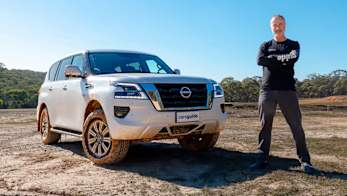The Porsche 718 Spyder is the big boss of Boxsters - the soft-top equal to the king of the hard-top Caymans, the weapon that is the GT4.
Not only does it share the same large naturally aspirated flat-six engine as the GT4 but the Spyder is now, for the first time, mechanically identical to that beast. So it’s way more than just another Boxster. In fact, it’s even dropped its Boxster surname and only wants to be referred to as 718 Spyder, thanks very much.
I welcomed the 718 Spyder into my home where it become my daily driver and I discovered how to get that roof up seconds before it rained, what the six-speed manual is like to live with in traffic, what it’s like to park with a restaurant full of people watching me, how much luggage the boots can take, and, of course, what it’s like to pilot on magnificent roads away from the city streets.
Porsche 718 2020: Spyder
| Engine Type | Flat 6, 4.0L |
|---|---|
| Fuel Type | Premium Unleaded Petrol |
| Fuel Efficiency | 11.3L/100km (combined) |
| Seating | 2 |
| Price From | $141,240 - $162,360 |
What's it like to drive?
9 / 10
Let’s get straight to the business end of this review, and I’m not talking about its price and features. Nope, let me tell you about how every time I got out of this car, I was shaking like a kid coming off a rollercoaster who then wanted to sprint around to the back of the queue and ride it again immediately.
Like a rollercoaster, the 718 Spyder isn’t overly comfortable, though you’re not going to find many people complaining about that, not when it’s so much fun. But you should know that the 718 Spyder is loud, the ride is on the harder side of firm, and if you’re as lanky as me or taller (I’m 191cm), then finding a driving position where your knee doesn’t hit the steering wheel on each gear change can be tricky. And then there’s getting out of it.
Yet all the discomfort I experienced was worth it, because in exchange, the Spyder 718 offers driving nirvana on the right road.
As I said in the intro to this review, the 718 Spyder was my daily for about a week. This test car had the six-speed manual gearbox and I’ve listed the options in the features section below, but there were no performance enhancing bits of equipment fitted. That was fine, because the car in its standard form is superb to steer straight out of the box.

The 718 Spyder is mechanically identical to the Cayman GT4. I’ve driven plenty of Caymans before but not this new GT4, but I suspect it would be fair to say that the Spyder is just as dynamically adept as it’s hard-top sibling - and, given the roof comes off, the experience could be even more of a sensory overload.
Fire up the engine and the 718 Spyder explodes into life. That start-up annoyed the heck out of my neighbours, I’m sure, but I couldn’t get enough of it. That initial blast settles down to an inoffensive idle, but you can bring the volume up again with a press of the exhaust button. That familiar sound of the naturally aspirated flat-six is the sweetest of songs to the ears of Porsche purists and the 718 Spyder’s voice won’t disappoint.
But even if it’s not the most beautiful sound you’ve ever heard, then the 420 horsepower that 4.0-litre boxer engine produces, and the way it’s delivered, will make you grin. The grunt is there under your foot from about 2000 rpm all the way towards 8000rpm.
Gear changes are quick and easy throws, although the left leg gets a workout from a fairly heavy clutch pedal. The brake pedal is high-placed, and while having almost no travel to it at all, commands excellent stopping power through giant 380mm discs all round with six-piston calipers at the front and four-piston calipers at the rear.
In his review of the Cayman GT4, CarsGuide editor Mal pointed out that, without a racetrack, the Porsche's true capabilities can never be unlocked, and the same goes for the Spyder. Still, there’s a country road I know which lends itself to testing sports cars legally, and it gave me a glimpse of this dynamically superb car’s talents.

Along with that naturally aspirated six which delivers its grunt so predictably, there’s the light front end which points instantly where you tell it to through steering which, while a little heavy, offers fantastic feedback. The handling is outrageously good. The result is a sports car that flows like water through corners, with the driver feeling not just in control but a part of the machine.
'Full noise' is a term often used to describe the roar of an engine during moments of wide-open throttle, and while V8s can sound burly and tough, the primal scream of a naturally aspirated flat six from behind your shoulder blades is… emotional.
Not all the noise is good. The thin fabric roof does little to insulate the cabin from the world around you, and trucks, motorbikes - even the ping and pang of rocks and sticks flicking up against the under carriage - welcome their way into the cabin. Drive next to a concrete wall on a motorway and the sound reverberating back at you isn’t pleasant at all.
Then there’s the firm ride which, during the fun parts of a nice country road, you’ll not notice, but back in reality, on the cratered roads of Sydney’s suburbs and city, speed bumps and pot holes made me wince if I couldn’t dodge them first. Those 20-inch rims are wrapped in 245/35 rubber at the front and 295/30 at the rear, so they grip but also let you feel everything.
You’ll also smell everything with the top down. It’s one of the best things about convertibles. With no roof you’re instantly connected with the landscape, not just visually, but through the scents, too. There’s a creek under the bridge I cross on my test drive and at night with the top off I could smell the water and feel the change in temperature on my cheeks and neck as the road dropped down.
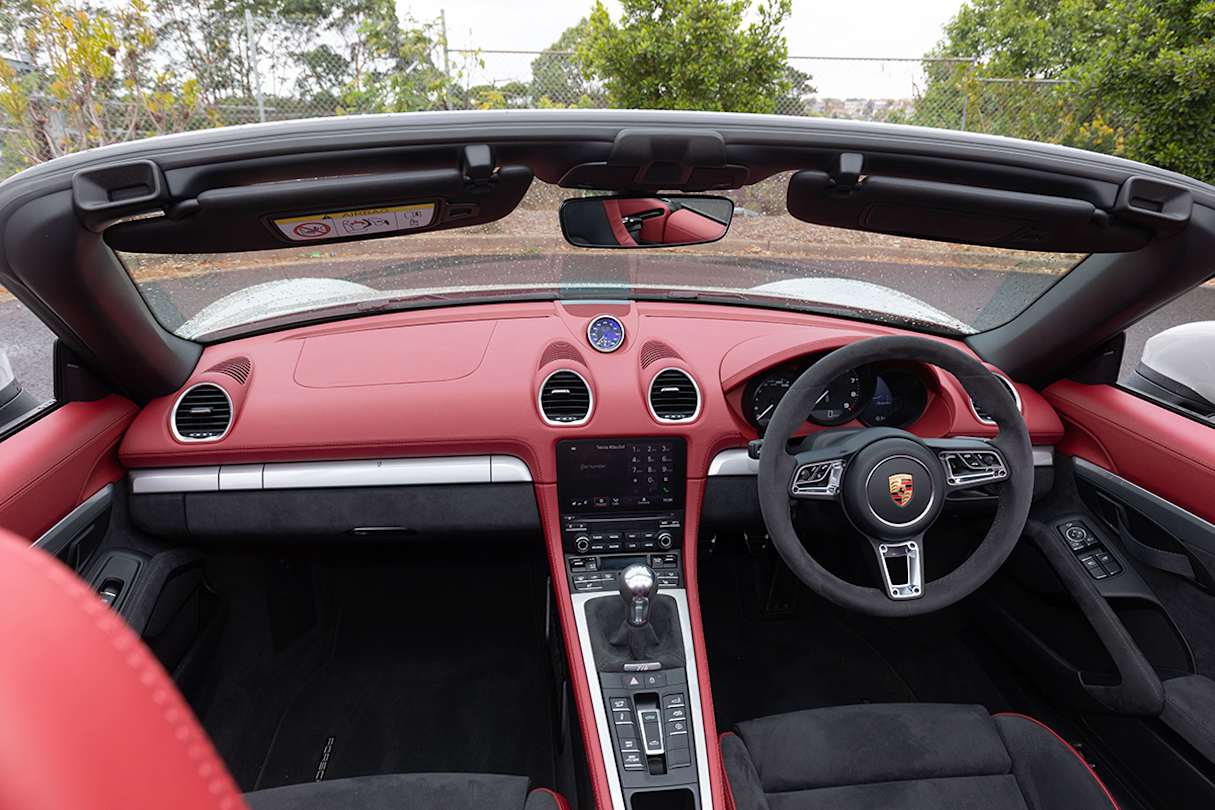
Does the lack of roof affect rigidity and the way the car drives? The chassis felt stiff and I couldn’t detect any signs of the scuttle shake that can sometimes happen without a metal roof holding everything down.
And then there’s the issue with my body. Well, it’s mainly my legs. They’re very long and they don’t work well with Porsche Spyder interiors, actually I have the same issue in the Cayman and the current and previous generations of the 911 - in particular the ones with clutch pedals. See, there’s no way for me to release the clutch without hitting the steering wheel with my knee regardless of how I adjust the steering column or the seat. That forces me to drive with my left legged cocked to the side.
But it was all worth it, as was getting out on all fours because you’re pretty much sitting on the ground in the Spyder. Because the reward in return is a ride you’ll want to take again and again.
Does it represent good value for the price? What features does it come with?
7 / 10
So, how much does that ride cost? The Porsche 718 Spyder with the manual gearbox is $196,800 (the seven-speed, dual-clutch PDK is about $5K more). Its hard-top Cayman GT4 sibling lists for $206,600.
Arriving standard are automatic Bi-Xenon headlights, 20-inch alloy wheels, dual-zone climate control, heated sports seats with power adjustment, black leather/Race-Tex (similar to Alcantara) upholstery, heated GT sports steering wheel wrapped in the same Race-Tex, a media display with Apple CarPlay, sat nav, digital radio and a six-speaker stereo.
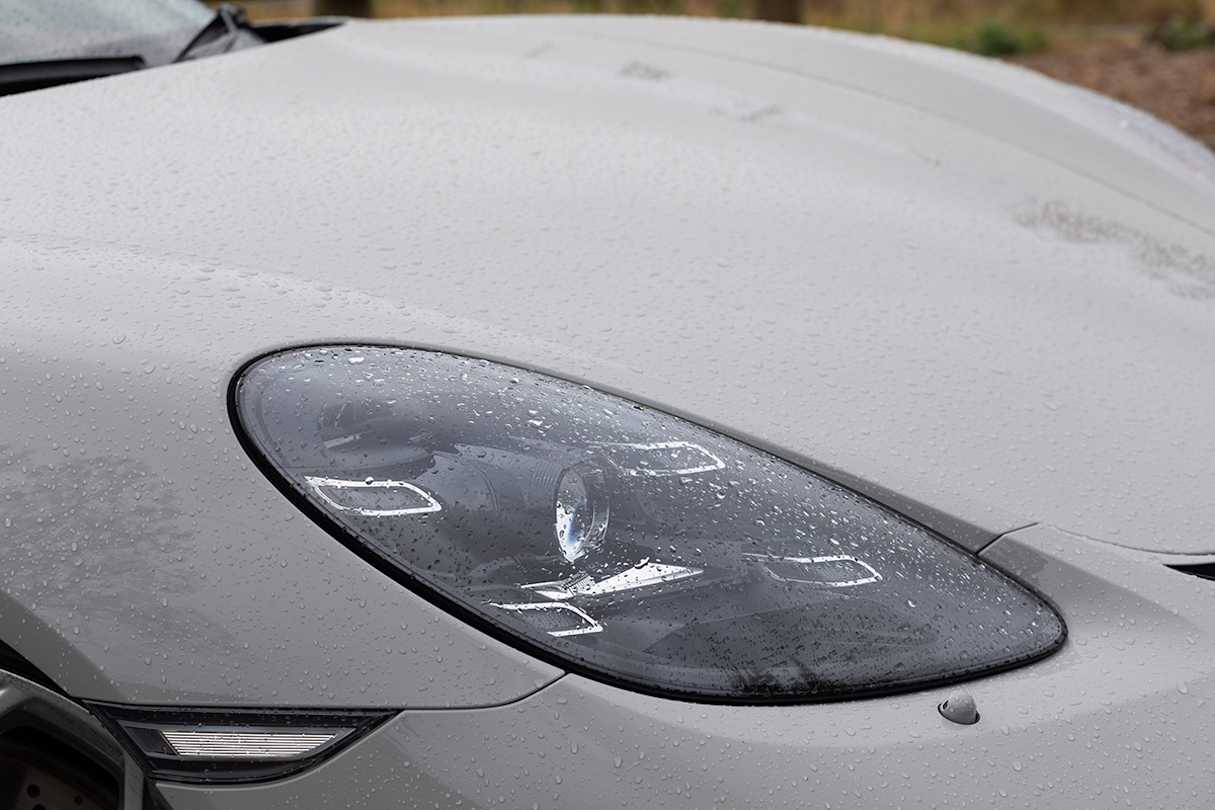
Now that’s not a great deal of goodies, not when you compare the Spyder’s standard features list with say, a Porsche Cayenne SUV which comes loaded with equipment.
Our test car was fitted with a few options, too. There were the adaptive sports seats ($5150), the Crayon paint ($4920), the Spyder Classic Interior package with Bordeaux Red and Black two tone upholstery ($4820), Bose sound system ($2470), LED headlights ($2320), power folding mirrors ($620), and if you want the Porsche lettering in satin black it’ll be another $310.
From an engineering bang-for-buck viewpoint, the Spyder is outstanding value, but in terms of features and equipment I don’t think it’s terrific. There’s no proximity unlocking or adaptive cruise control, the display screen is small, there’s no Android Auto, or a head up display, nor a large digital instrument cluster.
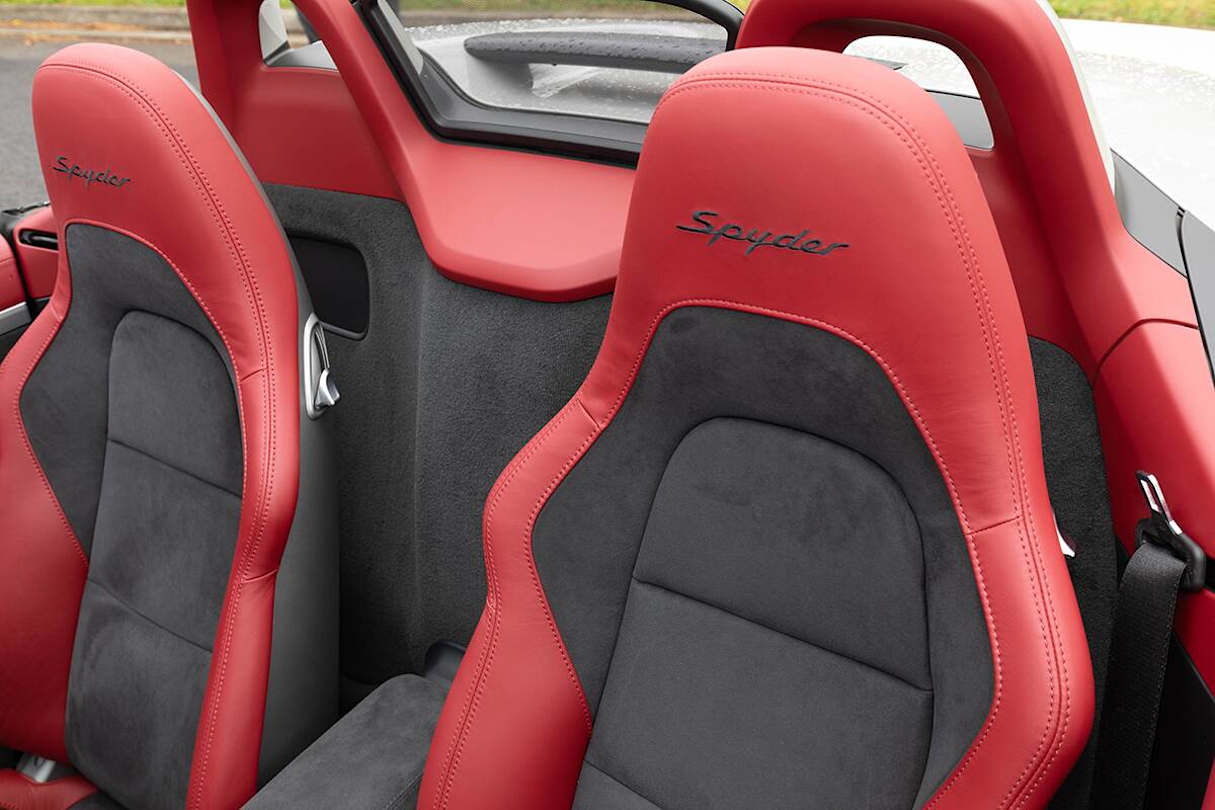
Is there anything interesting about its design?
9 / 10
The 718 Spyder design with its headrest fairings is a tribute to Porsche’s 718 racing roadsters of the late 1950s and early '60s, such as the 550 Spyder. Those fairings are also an easy identifier that this isn’t just another Boxster, and so is the fabric roof and the way it fastens to the rear boot lid.
Aside from that soft top the Spyder shares many of the same good looks as the Cayman GT4. Sure, the Spyder doesn’t have the giant fixed rear wing of the GT4, nor the duck tail spoiler under it, but they both have the same GT-style face with those enormous air inlets.
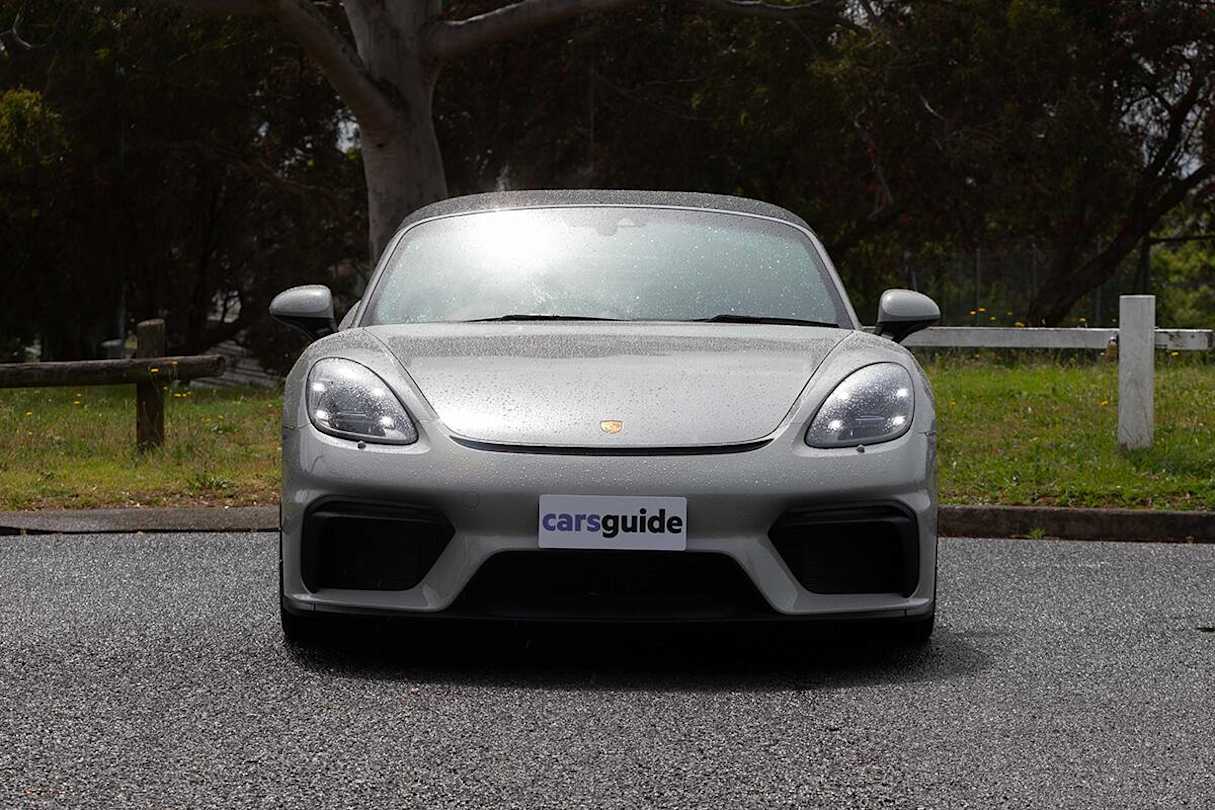
As with Porsche GT sports cars, air is channelled through that central lower inlet to the centre radiator, and then exits at the grille in front of the boot lid. This front section has also had a major redesign in this latest incarnation to reduce lift.
At the back, the Spyder’s diffuser produces 50 per cent of the total downforce on the rear axle, while a rear spoiler lifts automatically, although it only wakes up and gets out of bed once you hit 120km/h.
Our test car had the Spyder Classic Interior Package, which adds the Bordeaux Red upholstery. It’s a simple but elegant cockpit. I like the way the air vents have their own fairings, there’s the classic Porsche instrument cluster layout, the stopwatch sitting high on the dash (part of the standard Chrono Package), and then there are those retro strap door handles. All of this is identical to the GT4’s cabin, too.
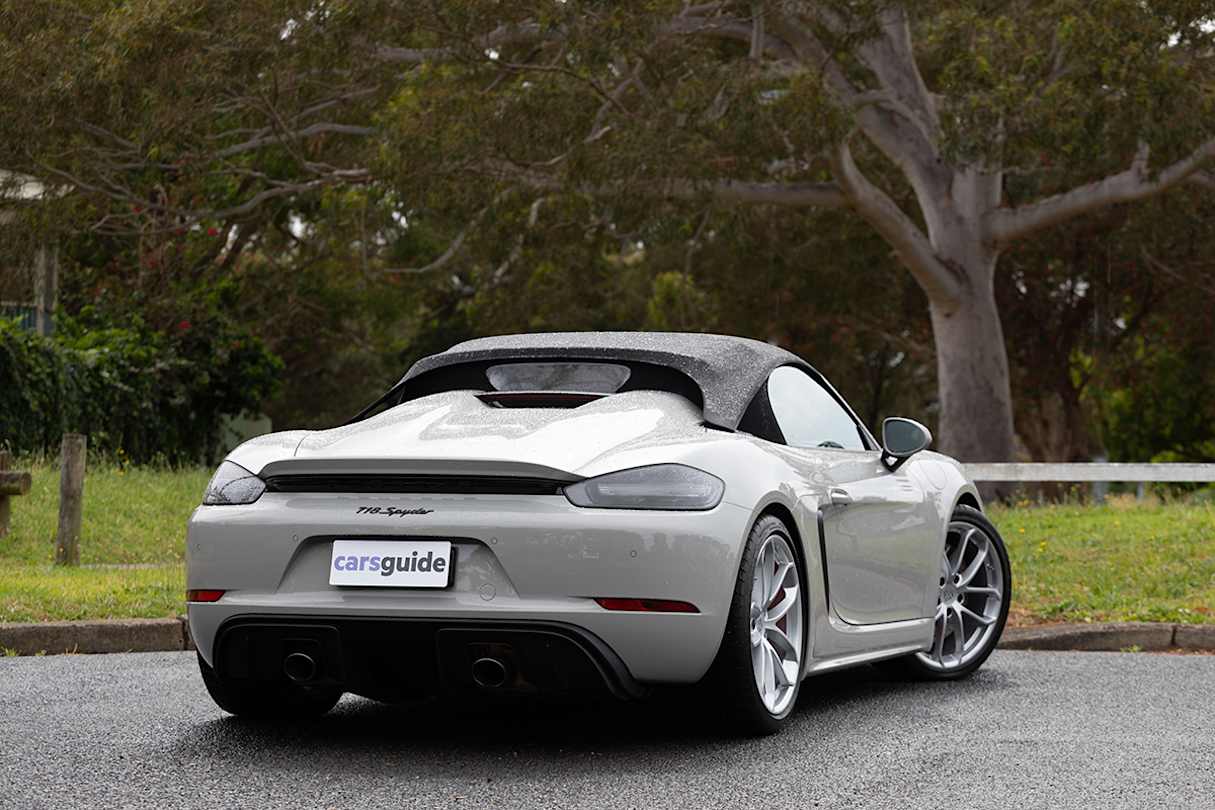
The Spyder is 4430mm end to end, 1258mm tall and 1994mm wide. So it's not an overly large car, and that made it easy to park, especially with the roof off.
There was one occasion where I found a park right out the front of the restaurant we were going to. The only problem was a little BMW i3 had just squeezed out of the tiny space. But we fit, and it was made all the easier because the roof was off at the time, and that improves over-the-shoulder visibility. Those headrest fairings do make it hard to see what's directly behind you, however.
How practical is the space inside?
8 / 10
As far as roadsters go the Spyder is super practical when it comes to luggage space, with a 150-litre rear boot and a 120-litre front boot. I should point out, though, that the rear boot can’t be opened without releasing the roof at the windscreen. I’ll get to how the roof folds in a moment.
Cabin storage is in short supply, with the expandable door pockets being your best bet to place wallets and other items because the centre console box is tiny, and the glove box is, too. There are two cupholders, though, which pop out above the glove box and coat hooks on the seat backs.
As for people-space, headroom with the roof on is good, and so too is shoulder- and elbow room, although if you have long legs like me you might find your knee hits the steering wheel when changing gears.

Now the roof. I could run a course on how to put it up and down, I’m so familiar with it now. What I can tell you briefly is that it is not an automatic folding roof, and while putting it down is fairly straight forward, putting it back on again is not so simple. It’s too heavy, too fiddly, and it takes too long. This is one part of the Spyder that should be changed.
The first time I had to put the roof back on a thunder storm was rolling in – it took almost five minutes to work out how to do it. Sure, after living with the car for a week I could put the roof on in less than two minutes, but still, there are many roadsters that can do this automatically, while driving, in seconds. So while practicality is good in terms of space, I’m taking marks off for the way the roof works. Still, the mechanics of an auto-folding roof would add weight, and that's against the ethos here.
The Porsche 718 Spyder has just two seats, and if you, like me, have a small child then you'll have to take another car to drop them off at preschool.
What are the key stats for the engine and transmission?
9 / 10
The Boxster and Boxster S have flat four-cylinder turbo petrol engines, the Boxster GTS 4.0 has a flat six-cylinder, and the Spyder has the same engine, but tuned to make 15kW more power (309kW) but identical torque at 420Nm. As with the hard-top Cayman line-up, all are rear-wheel drive, mid-engined cars.
So, while the outputs of the lower level Boxsters aren’t far off the Spyder’s, what’s different is that the Spyder's engineering is the same as the Cayman GT4’s - from that big, naturally aspirated engine to the chassis, and also much of the aerodynamic design.
My test car had the six-speed manual, but you can also have the option of a seven-speed dual-clutch PDK auto.
If you’re thinking of getting the Spyder as a second or third car - something you can just take for a blast occasionally - then the manual is the way to go. If you plan on driving the Spyder daily (I bow down to you in respect), and you live in the city, then consider making ‘living the dream’ a bit easier and opt for the auto, because even after just a few days I was over the constant clutch pedal dance.
The Spyder can sprint from 0-100km/h in 4.4 seconds, again identical to the GT4, although the soft top’s maximum speed of 301km/h is just shy of the hard top’s 304km/h.
Those are go-straight-to-jail figures on Australian roads, which is why a racetrack is the best place to really get the most of out a Spyder or GT4. Both would make great track cars at a lot less than the price of a Porsche 911 GT3, and with only 59kW and 40Nm less power and torque.
How much fuel does it consume?
8 / 10
Porsche says the Spyder should use 11.3L/100km of premium unleaded petrol after a combination of open and urban roads. My own testing took in 324.6km, about half of which was on city and suburban adventures, while the rest was a decent drive in more rural environs. The trip computer was reporting an average of 13.7L/100km which isn’t bad considering I was in no way attempting to save fuel.
The Spyder, like its Boxster brothers, has a 64-litre fuel tank.
Warranty & Safety Rating
What safety equipment is fitted? What safety rating?
6 / 10
The 718 Spyder may well be an engineering masterpiece built to perform with dynamic perfection, but when it comes to safety technology it's severely lacking. There is no ANCAP nor EuroNCAP safety rating either. ANCAP is on the record as being frustrated by many high-end car brands’ unwillingness to supply vehicles for crash testing
What we do know is there are enormous brakes which are vented and cross drilled, a fixed rollover bar, airbags (including thorax airbags integrated in the side bolsters of each seat), plus traction and stability control, but there is nothing in the way of advanced safety equipment. We’re talking no AEB at all, nor cross traffic alert. There’s cruise control, but it’s not adaptive.
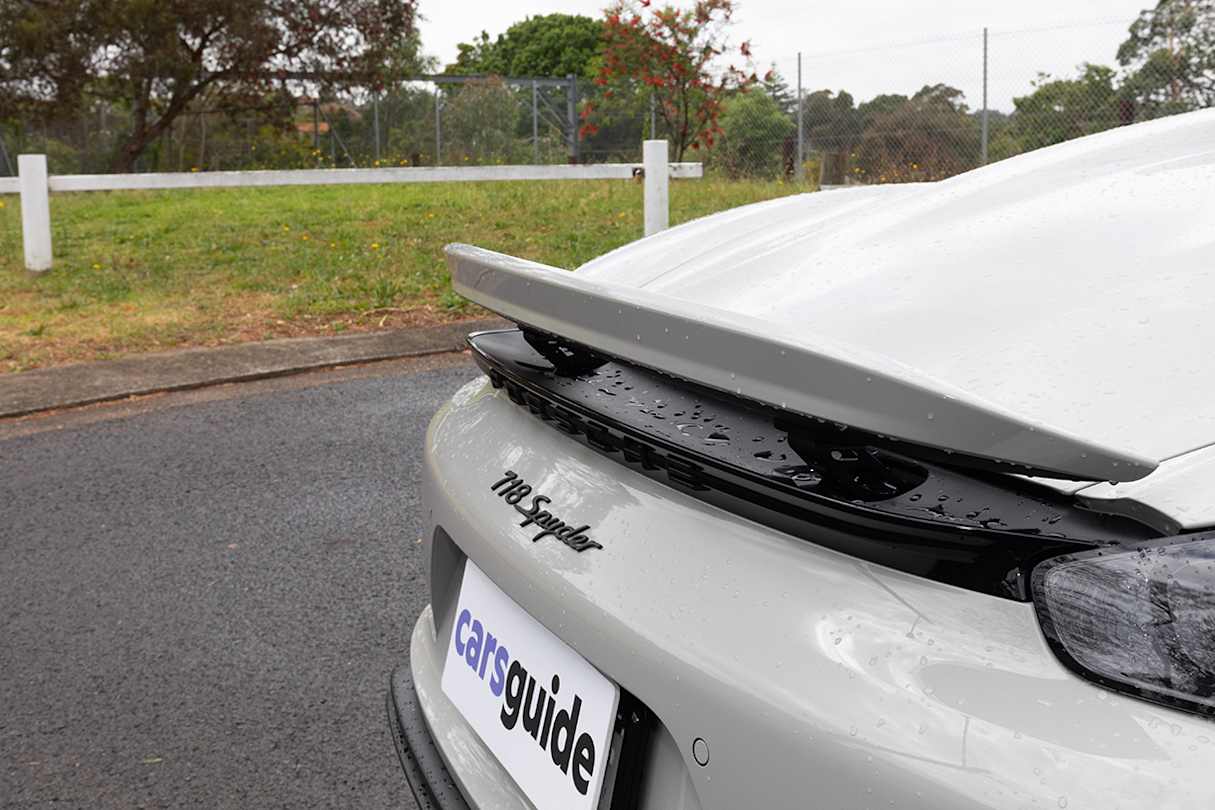
When you consider there are cars for $30K with full suites of advanced tech to protect their owners it makes you wonder why Porsche hasn’t done the same.
You could argue that these are ‘race cars for the road’, but I would retort that this is all the more reason for advanced safety to be included.
What does it cost to own? What warranty is offered?
7 / 10
The Spyder is covered by Porsche’s three-year/unlimited-kilometre warranty. Servicing is recommended every 12 months or 15,000km.
Servicing prices are set by the individual dealership service centres.
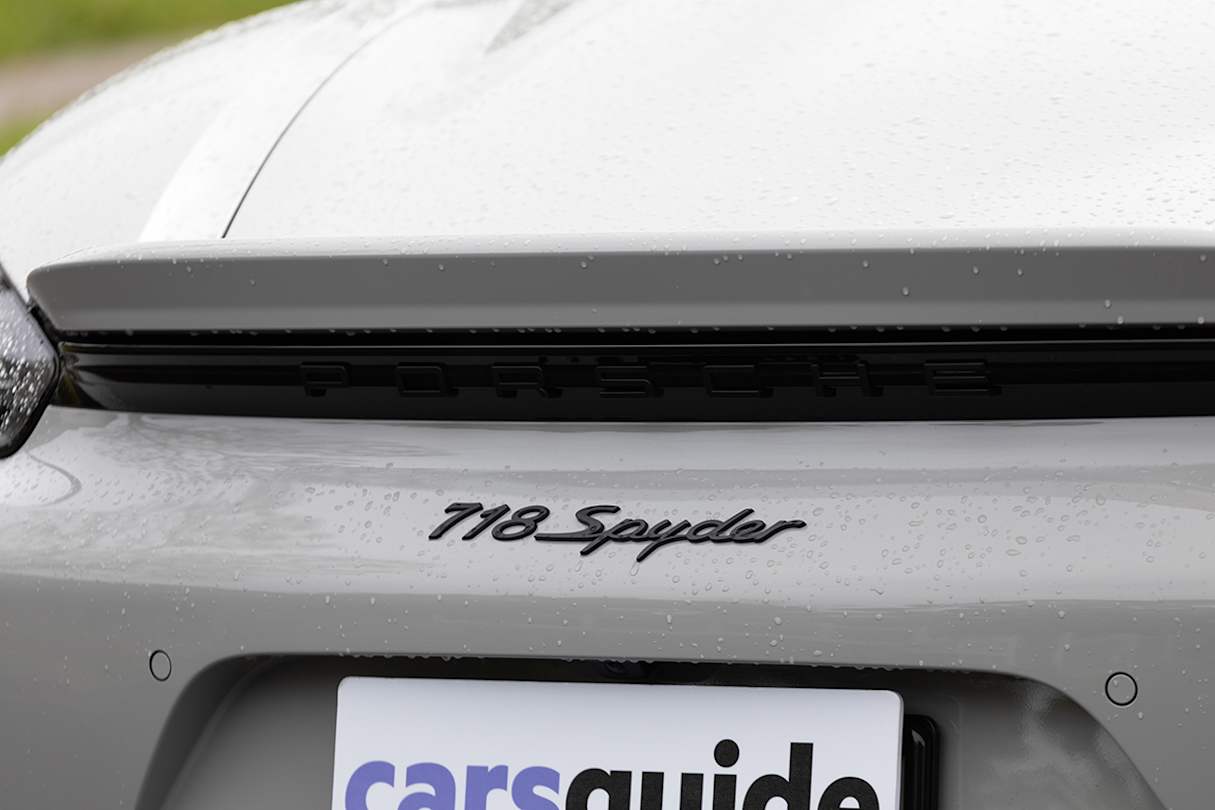
Verdict
The 718 Spyder could well find a home in a garage of several cars, which would be ideal given that it could be too much like hard work to drive daily – especially the manual version I tested.
But to take it out occasionally on a trip, with plenty of room for luggage, and let it run free through flowing corners, fast bends and great roads away from the city streets? That’s what the 718 Spyder is all about.


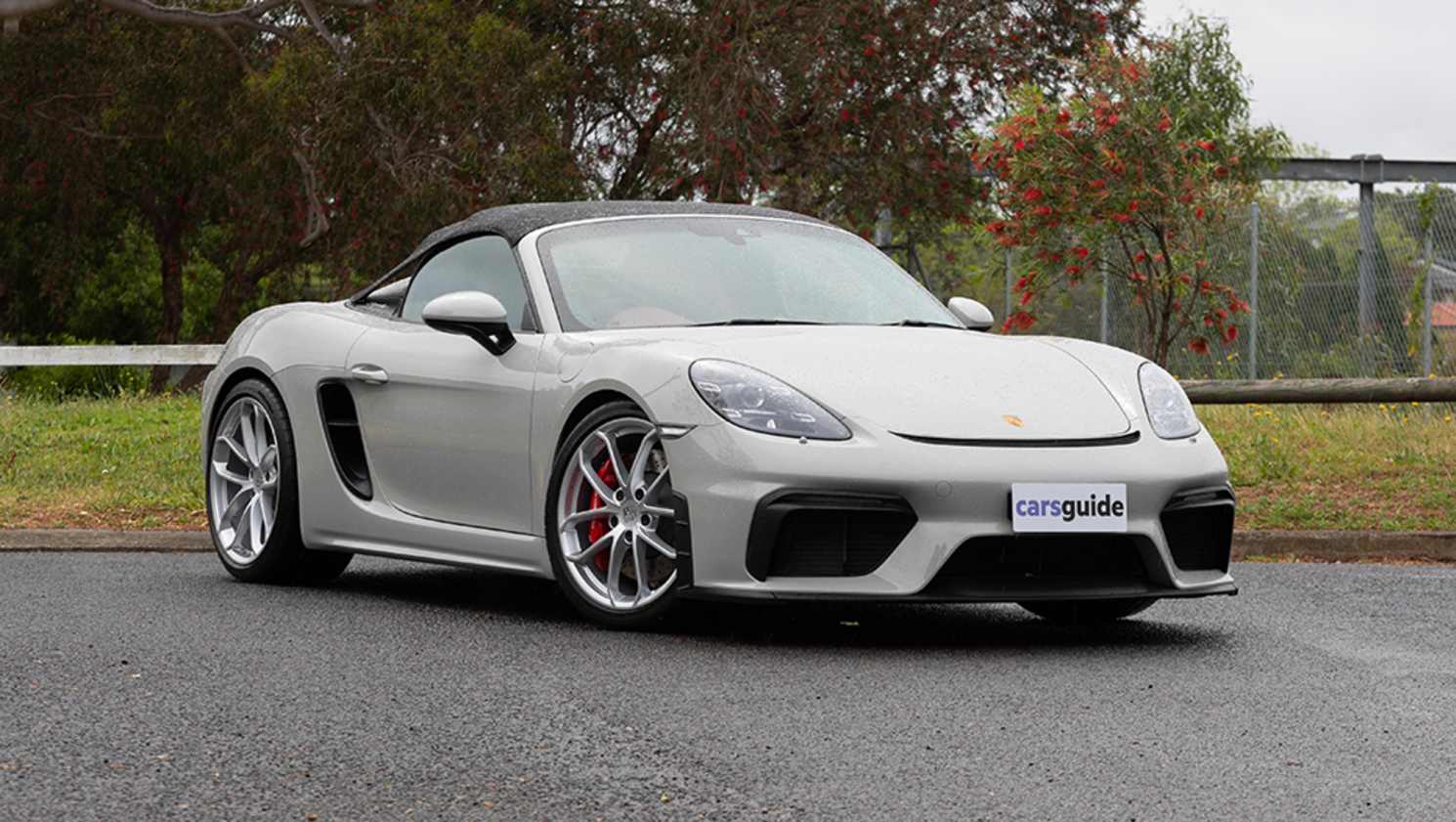







.jpg)






































.jpg)
.jpg)
.jpg)
.jpg)


